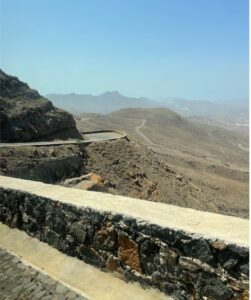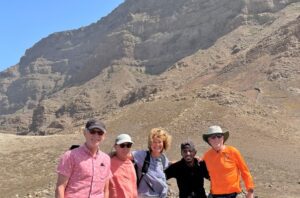Joseph
Friday, Feb 11, 2022
Currently Position:
Latitude 16o 50’ N
Longitude 32o 53’ W
Retrospective
Mindelo Marina, Cabo Verde
Joseph
In what now seems long ago, the current crew rendezvoused in the Canary Island at the end of January, with St. Lucia as our destination, approximately 2800 miles to the southwest. Looking at a map of the globe it would seem as if the quickest path would be to follow the great circle route straight between the two. Instead, we headed 800 miles south with a stopover in Cape Verde before turning West, adding extra miles to the voyage, but ensuring that we would be in the trade winds for the last 2100 miles.
The rational for stopping over in Cape Verde was, in part, that it seemed only prudent to include an intermediate landfall given the frequency of unexpected repairs since leaving Maine in June. Fortunately, Cape Verde turned out to be an unnecessary repair stop, other than the opportunity to repack the spinnaker in the relative calm of the marina pier. A planned stop in Cape Verde also provided the opportunity to take on fresh fuel, water, and groceries in order to start the crossing to the Caribbean with a fully restocked boat. And it provided the crew with a chance to rest and relax. Even better, it provided Denise Munger the opportunity to join the crew for our first eight days at sea before she had to head home to more mundane responsibilities.
Anyone sailing from the Canaries to the Caribbean should consider a stopover at the Mindelo Marina in Cape Verde not just for the rest, recreation, and resupply, but for the unique experience. The marina has an expatriate atmosphere to it, with boats and crews from around the world. At the floating restaurant and bar, one would frequently find a sun-bleached sailor visiting table to table carrying a cute, scruffy dog under his arm. Another sported a monkey on his shoulder. Sitting at a far table was a young couple faithfully dressed in lederhosen, despite the bright sun and 80-degree temperatures. And there was a variety of individuals with a variety of resumes looking to crew with anyone that would take them across the Atlantic. How long they’d been there or how long they might stay before finding a way out was indeterminant. At night, local talent would set up their equipment at the bar and perform as locals and transients danced to the music. As Denise commented, if everyone would only come listen to the music at the Mindelo Marina floating bar, we’d all get along.
And if you do sail into Mindelo, look up Joseph (238 998 9689) standing at the end of the Mindelo Marina pier offering tours of the island for 20 Euros/passenger. His van was old and tired, with rips in the upholstery, but it had plenty of room with four rows of seats and, most importantly, it appeared to be mechanically sound. Denise made the arrangements, and we all came back the next morning and climbed in. On the way out of town, Joseph proudly pointed up the street to where his wife, son and daughter lived and then stopped at a local gas station, asking us for an advance to add ten Euro’s worth of fuel. As we continued out of the neighborhood, people along the street would wave at him in recognition.
Within ten minutes we were outside the residential area and winding our way to the top of the island along an arid stone road that rivals the great wall of China in its workmanship, if not size and extent. It is carved into the steep sides of the mountain, edged by solid rock guard rails, and paved with meticulously placed irregular stones that must number in the millions. Like the Great Wall, it’s hard to imagine the labor involved.

The road to the top of Sao Vincente, Capo Verde

Brimmer, Burke, Denise, Joseph, and Dwight
Once at the top, the view was expansive. We could see the full way down to the harbor of Mindelo, although the visibility that day was not good, due to the fine sands blowing in from Africa. Of more interest at the top was the stone hut and the gentleman inside offering coffee and samples of liquors made from local herbs. Some of the crew concluded that a shot would make the ride back down the shear cliffs more relaxed. And, perhaps the most interesting experience was a four meter wide fence of stretched fabric that captures and condenses the almost non-existent moisture in the winds that blow over the top of the mountain. Miniscule beads of water drip from the bottom of the fabric into a plastic lined trough that feeds into a cistern. Joseph lifted the lid and filled a pail with water that he then drizzled on a small garden nearby. It was an amazing testimony to the creativity of humans to adapt and survive in a harsh environment.
After our brief time at the top, Joseph successfully got us back down the road to the lowlands, where he continued the afternoon with a stop for lunch and a complete tour of towns and beaches around the island. What I will remember most about our day with Joseph is his enthusiasm and pride in showing off the island, in stark contrast with the broken windmills, dried up crops, and dilapidated buildings and houses along the way.